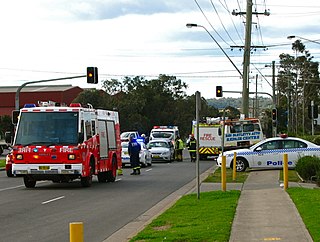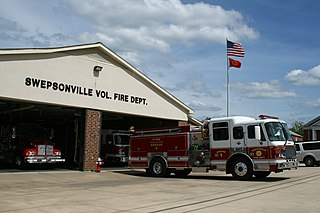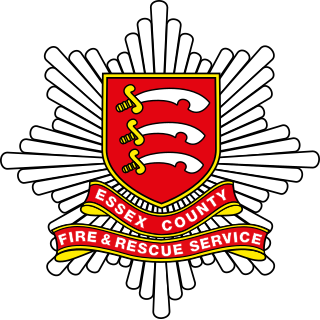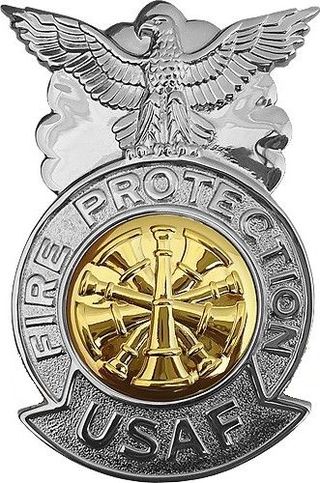
A firefighter is a first responder trained in firefighting, primarily to control and extinguish fires that threaten life and property, as well as to rescue persons from confinement or dangerous situations. Male firefighters are sometimes referred to as firemen.

Emergency services and rescue services are organizations that ensure public safety, security, and health by addressing and resolving different emergencies. Some of these agencies exist solely for addressing certain types of emergencies, while others deal with ad hoc emergencies as part of their normal responsibilities. Many of these agencies engage in community awareness and prevention programs to help the public avoid, detect, and report emergencies effectively. Emergency services are often considered first responders, and typically have dedicated emergency vehicles.

A volunteer fire department (VFD) is a fire department of volunteers who perform fire suppression and other related emergency services for a local jurisdiction. Volunteer and retained (on-call) firefighters are expected to be on call to respond to emergency calls for long periods of time, and are summoned to the fire station when their services are needed. They are also expected to attend other non-emergency duties as well.

Firefighting is a profession aimed at controlling and extinguishing fire. A person who engages in firefighting is known as a firefighter or fireman. Firefighters typically undergo a high degree of technical training. This involves structural firefighting and wildland firefighting. Specialized training includes aircraft firefighting, shipboard firefighting, aerial firefighting, maritime firefighting, and proximity firefighting.
In firefighting, the policy of two-in, two-out refers to United States Occupational Safety and Health Administration (OSHA) policy 29 CFR 1910.134(g)(4)(i). The respiratory protection standard requires that workers engaged in fighting interior structural fires work in a buddy system; at least two workers must enter the building together, so that they can monitor each other's whereabouts as well as the work environment. There must also be at least two standby personnel outside the fire area prepared to rescue the inside firefighters should the need arise. One of these outside firefighters must actively monitor the status of the inside fighters but the second outside firefighter may perform a variety of other duties, such as pump operations, incident commander or outside hose line operation. There are no provisions in the standard to waive the requirements for either the "two-inside firefighters" or the "two-outside firefighters", although the circumstances under which this provision applies are more limited than generally understood.
Firefighting jargon includes a diverse lexicon of both common and idiosyncratic terms. One problem that exists in trying to create a list such as this is that much of the terminology used by a particular department is specifically defined in their particular standing operating procedures, such that two departments may have completely different terms for the same thing. For example, depending on whom one asks, a safety team may be referred to as a standby, a RIT or RIG or RIC, or a FAST. Furthermore, a department may change a definition within its SOP, such that one year it may be RIT, and the next RIG or RIC.

The Los Angeles County Fire Department (LACoFD) provides firefighting and emergency medical services for the unincorporated parts of Los Angeles County, California, as well as 59 cities through contracting, including the city of La Habra, which is located in Orange County and is the first city outside of Los Angeles County to contract with LACoFD.
Junior firefighting is a youth activity mostly organized by fire departments. It serves as a means of personal development for the youths, as well as a recruiting pool for the fire departments.

The Danish Emergency Management Agency (DEMA) is a Danish governmental agency under the Ministry of Defence. Its principal task is to manage an operational part who work out of six Emergency Management Centres, and administrative and legalizing part, who supervises the national and municipal rescue preparedness and advises the authorities on matters of preparedness. DEMA works in closely structured co-operation with the EU, UN and several neighbouring countries.

The Fire and Rescue Department of Malaysia, commonly known as Bomba, is a federal agency of Malaysia responsible for firefighting and technical rescue. Bomba is a Malay word derived from the Portuguese bombeiros which means 'firefighters'.

firefighting in Finland is regulated by the Ministry of the Interior. Municipalities of Finland can choose whether the fire and rescue services are provided by a professional fire brigade, a half-ordinary fire brigade or a voluntary fire brigade. Half-ordinary and voluntary fire brigades rely on non-professional voluntary firefighters who have been trained appropriately. The main responsibilities of fire brigades are rescuing people, protecting property and the environment, limiting damage and consequences.

The National Interagency Fire Center(NIFC) in Boise, Idaho is the American physical facility which is the home to the National Interagency Coordination Center (NICC), and the National Multi-Agency Coordination group (NMAC or MAC).
As firefighting has a rich history throughout the world, traditions in this profession vary widely from country to country.

Essex County Fire and Rescue Service (ECFRS) is the statutory fire and rescue service for the county of Essex in the east of England, and is one of the largest fire services in the country, covering an area of 1,338 square miles (3,470 km2) and a population of over 1.7 million people.
An incident response team (IRT) or emergency response team (ERT) is a group of people who prepare for and respond to an emergency, such as a natural disaster or an interruption of business operations. Incident response teams are common in public service organizations as well as in other organizations, either military or specialty. This team is generally composed of specific members designated before an incident occurs, although under certain circumstances the team may be an ad hoc group of willing volunteers.
Emergency is a series of real-time strategy simulation video games by German developer Sixteen Tons Entertainment, designed by Ralph Stock. In the games, players control emergency services—namely police, fire, emergency medical services, and technical services—and command operations to handle a variety of emergencies.

Firefighting in the United States dates back to the earliest European colonies in the Americas. Early firefighters were simply community members who would respond to neighborhood fires with buckets. The first dedicated volunteer fire brigade was established in 1736 in Philadelphia. These volunteer companies were often paid by insurance companies in return for protecting their clients.

The United States Air Force Fire Protection career specialty is the military's premiere specialty in fire protection. Much like their civilian counterparts, these military firefighters protect people, property, and the environment from fires and disasters. They provide firefighting, specialized rescue, HazMat responses, as well as provide fire prevention and response to weapons of mass destruction. Though every branch has its own fire protection career specialties, they all must graduate from the Air Force's 13.5 week fire academy in San Angelo, Texas before being awarded their Firefighter certification.
A Special operations firefighter, also known as Fire Service Special Operations, is a specialist firefighter who has been specially trained to execute tasks other than standard firefighting operations. The National Fire Protection Association's Standard for the Organization and Deployment of Fire Suppression Operations, Emergency Medical Operations, and Special Operations to the Public by Career Fire Departments defines special operations as "Those emergency incidents to which the fire department responds that require specific and advanced training and specialized tools and equipment". The NFPA 1710 further defined special operations as "Special operations include water rescue, extrication, hazardous materials, confined space entry, highangle rescue, aircraft rescue and fire fighting, and other operations requiring specialized training".












